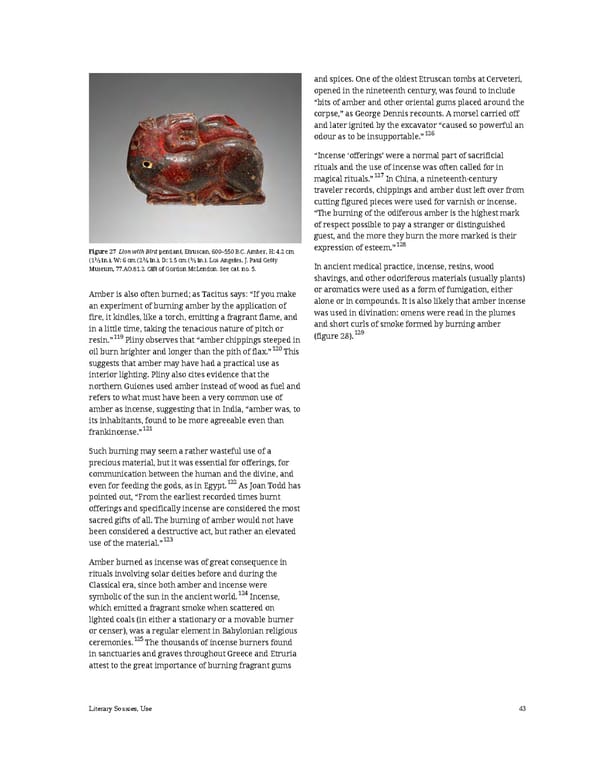and spices. One of the oldest Etruscan tombs at Cerveteri, opened in the nineteenth century, was found to include “bits of amber and other oriental gums placed around the corpse,” as George Dennis recounts. A morsel carried off and later ignited by the excavator “caused so powerful an odour as to be insupportable.”126 “Incense ‘offerings’ were a normal part of sacrificial rituals and the use of incense was often called for in magical rituals.”127 In China, a nineteenth-century traveler records, chippings and amber dust left over from cutting figured pieces were used for varnish or incense. “The burning of the odiferous amber is the highest mark of respect possible to pay a stranger or distinguished guest, and the more they burn the more marked is their expression of esteem.”128 Figure 27 Lion with Bird pendant, Etruscan, 600–550 B.C. Amber, H: 4.2 cm (13⁄5 in.), W: 6 cm (23⁄8 in.), D: 1.5 cm (3⁄5 in.). Los Angeles, J. Paul Getty Museum, 77.AO.81.2. Gift of Gordon McLendon. See cat. no. 5. In ancient medical practice, incense, resins, wood shavings, and other odoriferous materials (usually plants) Amber is also often burned; as Tacitus says: “If you make or aromatics were used as a form of fumigation, either an experiment of burning amber by the application of alone or in compounds. It is also likely that amber incense fire, it kindles, like a torch, emitting a fragrant flame, and was used in divination: omens were read in the plumes in a little time, taking the tenacious nature of pitch or and short curls of smoke formed by burning amber 119 (figure 28).129 resin.” Pliny observes that “amber chippings steeped in oil burn brighter and longer than the pith of flax.”120 This suggests that amber may have had a practical use as interior lighting. Pliny also cites evidence that the northern Guiones used amber instead of wood as fuel and refers to what must have been a very common use of amber as incense, suggesting that in India, “amber was, to its inhabitants, found to be more agreeable even than frankincense.”121 Such burning may seem a rather wasteful use of a precious material, but it was essential for offerings, for communication between the human and the divine, and even for feeding the gods, as in Egypt.122 As Joan Todd has pointed out, “From the earliest recorded times burnt offerings and specifically incense are considered the most sacred gifts of all. The burning of amber would not have been considered a destructive act, but rather an elevated use of the material.”123 Amber burned as incense was of great consequence in rituals involving solar deities before and during the Classical era, since both amber and incense were symbolic of the sun in the ancient world.124 Incense, which emitted a fragrant smoke when scattered on lighted coals (in either a stationary or a movable burner or censer), was a regular element in Babylonian religious ceremonies.125 The thousands of incense burners found in sanctuaries and graves throughout Greece and Etruria attest to the great importance of burning fragrant gums Literary Sources, Use 43
 Ancient Carved Ambers in the J. Paul Getty Museum Page 52 Page 54
Ancient Carved Ambers in the J. Paul Getty Museum Page 52 Page 54